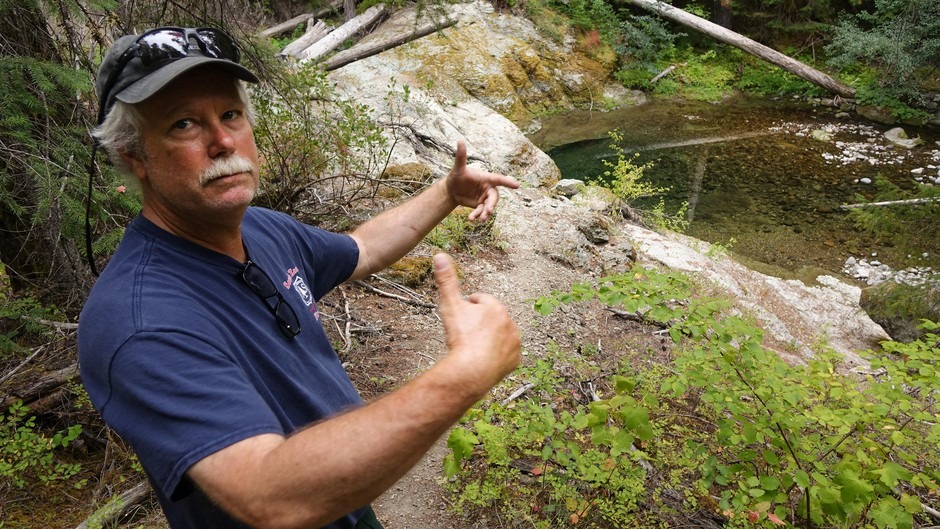
A Push To Protect Spring Chinook Salmon Gets A Boost From Genetic Science
Listen
BY JES BURNS / OPB
A logjam on a river can be a beautiful thing – especially if you’re a salmon. Logjams collect the gravel salmon need to lay their eggs.
But if you’re a spring chinook on the South Umpqua, the slick gray-green sheets of rock that line the course of the river can be a bleak place.
“The water just rips through it. And because the bedrock offers very little resistance, all the gravel and substrate just move out and don’t get retained,” Forest Service fisheries biologist Casey Baldwin said.
Baldwin has been working for more than a decade to add logs back to the river and improve its spawning habitat. Logs were pulled from the river by his agency in the 1960s and ‘70s in a misguided practice called “stream clean out,” where the logjams were removed in an attempt to make it easier for fish to get upstream.
“A lot of the river’s pretty much its base or worst state that it can be in. I mean, you really [can] say it’s a beautiful ditch of bedrock,” he said.
The progress has been slow. The past few years, Baldwin’s workforce has been busy fighting wildfires instead of being available for restoration work. And funding can be unpredictable from year to year.
Every year the river continues to resemble a massive bedrock waterslide, spring chinook numbers continue to fall. Only about 60 “springers” came back this year to the South Umpqua River.
“We’re looking at the last breaths of a species,” said Stanley Petrowski, a board member of Umpqua Watersheds.
Petrowski said spring chinook declines on coastal Oregon rivers haven’t been given the conservation attention they need because the spring and fall fish are lumped together and regarded as a single species. For decades, based on what scientists knew about salmon genetics, wildlife managers in the Pacific Northwest considered chinook salmon that return to deposit and fertilize eggs in the spring and those that return in the fall to be the same fish. So, even though wild spring chinook salmon runs on many rivers in Northern California and Oregon have crashed, there hasn’t been the urgency to change anything – as long as the fall runs remain strong.
Wildlife managers thought that if spring chinook salmon disappeared, then fall chinook would just re-evolve to start their homeward migration in spring – replenishing that run of fish.
But recently, there’s been a significant shift in our understanding of salmon genetics. Researchers have found a distinct area in salmon DNA where the spring and fall chinook differ.
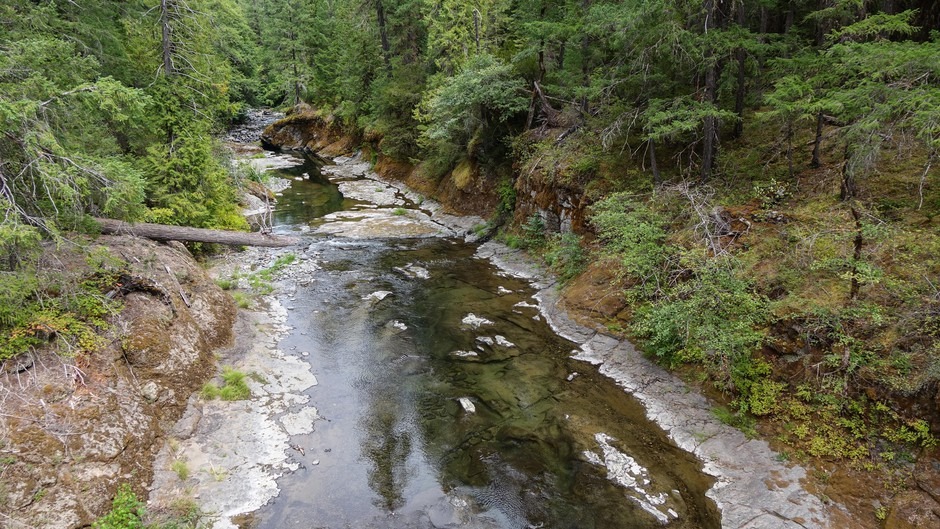
Most of the gravel spawning on the South Umpqua has scoured out, leaving only the bedrock behind. CREDIT: Jes Burns/OPB
“Now that we know that there’s a genetic difference, they should be managed as that. And that’s what we’re pushing for,” Petrowski said.
Umpqua Watersheds and other groups filed a petition based on this new science Tuesday. They want to extend Endangered Species Act protections to spring chinook in Oregon coastal rivers roughly between Port Orford and Seaside – a stretch that covers most of the Oregon coastline.
Genetic Revelations
Being a spring run chinook instead of a fall run chinook can definitely have advantages.
Spring chinook get their name because they enter rivers in spring when water flows are high and rivers are deep. This allows them to move farther inland to access spawning grounds. The fish hang out in cold river pools all summer while they develop the ability to reproduce.
By the time fall run fish leave the ocean, river flows are usually lower. What looked like a speed bump to a spring salmon might be more like a tall, insurmountable waterfall later in the year.
Both runs of fish spawn at roughly the same time (springers generally lay their eggs about a month earlier), but because spring fish access parts of the river fall fish can’t, they reduce the level of competition for spawning grounds.
The genetic difference between fall and spring chinook salmon was first documented in a 2017 paper coauthored by University of California-Davis geneticist Mike Miller. But scientists had been looking into the genetic differences between the fish since the 1970s.
“What [had] been found over and over again is that when you look at pairs of spring and fall chinook from the same watershed, the tend to be really related to each other … they were indistinguishable,” Miller said.
Based on this, scientists concluded that the fish first developed a preference for a specific home river before they evolved to return to that river at a different time of the year.
“It would suggest that the spring run evolved lots of different times in lots of different places,” he said.
If this change in behavior emerged many times in the past, what’s to say it couldn’t reemerge again when conditions are favorable?
Miller decided to look a little closer at the issue using new high-resolution genetic analysis technology.
“We were really surprised we found that there was one region of the genome that was basically … perfectly correlated with whether individuals were either spring run or fall run,” he said.
They did the same analysis for winter and summer runs of steelhead and found the same genetic variation between the two runs.
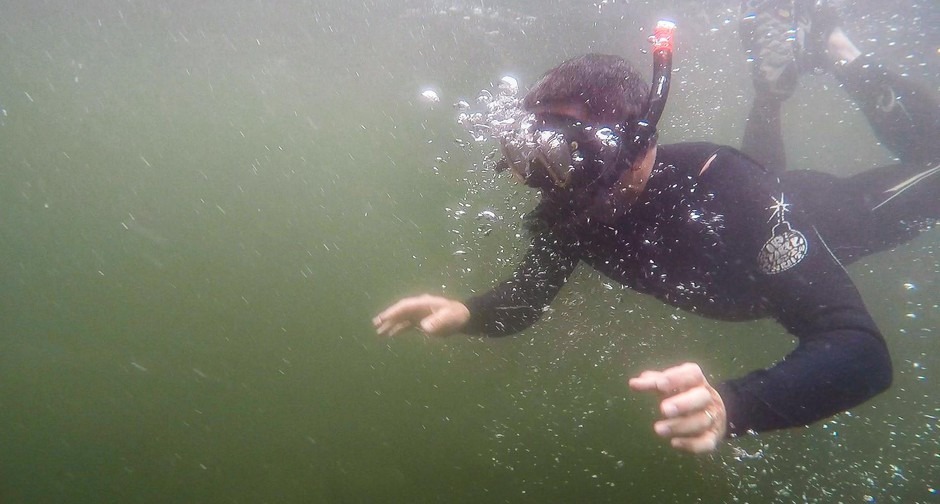
Craig Tucker, who works with the Karuk Tribe, searches for spring chinook in a hole on Wooley Creek in the Klamath Basin. CREDIT: Jes Burns/OPB
It didn’t matter where the spring chinook they analyzed came from, they all had the same genetic marker. This means the genetic mutation happened once, likely tens of thousands of years ago or more and then spread. This was not something that could be counted on to happen again in our lifetime.
This presented a new avenue to argue that spring chinook should be protected separately under the Endangered Species Act.
Matt Sloat, a scientist with the Wild Salmon Center in Portland, said the finding could be the “biggest thing to influence how the Endangered Species Act governs salmon in a long time.”
Trailblazers
The mutation that initially was an evolutionary boon for spring chinook salmon has left them particularly vulnerable because of the way humans have changed the rivers.
Dams were built that blocked off large chunks of the upstream habitat springers relied on, pitting them against fall fish in downstream spawning grounds. Wild fish advocates say hatcheries are undermining wild populations. The water quality of the rivers has been altered by land uses like logging, grazing and mining, and by communities withdrawing water for agriculture, drinking supplies and industrial use. River levels are lower and water temperatures are warmer, affecting spring fish that need cold water habitat to get them through the hot summer months.
This is the case on the Klamath River, which drains parts of Southern Oregon and Northern California. Once springers were the dominant run of fish, and very important to the Native American tribes in the region. Now the only stronghold of wild spring chinook left is found on a tributary called the Salmon River – if 161 fish can be considered a stronghold.
Amy Fingerle of the Salmon River Restoration Council wears a full black wetsuit, felt-soled boots and snorkel gear as she prepares to push off the rocks into a deep hole on the Salmon River. She points to the spot where Wooley Creek cascades into the larger river.
“I’d recommend that we go off to the side where the water is eddying out so we don’t disturb the fish as we’re popping in,” she said above the rushing water.
A few steps ahead, Craig Tucker, who works with the Karuk Tribe, called out in unabashed dad-joke glory: “Who’s this Eddie guy we keep looking for?”
“They like to nose into these creek mouths where the cold water is mixing with the river water,” Fingerle said, referring to the salmon, not Eddie. “We’ll hope that they’re there.”
Fingerle and Tucker slip into the pool, initially swept upstream by the force of Wooley Creek flowing in. They then make a wide circle on the surface and briefly rest in the calm of the eddy. The visibility is only about 10 feet in the turbid pool and they have to dive to see the bottom.
Underwater, they follow the cold water to the mouth of the creek, just like the spring chinook do.
Dive after dive, then pool after pool moving up Wooley Creek, they see small trout, a steelhead, some juvenile fish – but no returning adult spring chinook salmon.
“That’s disappointing,” Tucker said, emerging from a pool.
“There was no doubt in my mind that we’d come here and see spring chinook. This is prime habitat,” Fingerle said. “But you have a 161 fish that have returned, spread throughout the watershed. It’s almost becoming like a needle in a haystack.”
The Karuk Tribe and Salmon River Restoration Council were the first to use the new genetic science to try to get spring chinook listed as threatened or endangered. That petition is currently awaiting action from the National Marine Fisheries Service, which was supposed to issue a decision at the end of 2018.
A NMFS spokesperson said the decision is now expected before the end of this year. With this decision will come the first clue whether salmon conservation will change to reflect the expanding understanding of salmon genetics.
The Eyes Have It?
Not all scientists working in the field of salmon genetics agree on the interpretation of the new genetic data. In fact, a group of scientists working with Miller on the 2017 paper, removed their names before it was published.
NOAA Fisheries ecologist Carlos Garza was one of those scientists, although he agrees the underlying work showing the genetic difference between spring and fall chinook was good (and has subsequently been confirmed by his own, as yet unpublished, work).
Garza says the genes that mark spring run salmon only correlate with the time they enter rivers, not any other physical or developmental difference. And he says people are going too far with the interpretation of what the genetic difference means.
“If you’re proposing that we change the way that we label these fish to focus on something that is not descriptive of the way that they are actually existing in nature, then that … becomes an issue of anthropogenically categorizing things in a way that is not consistent with their biology,” he said.
In addition, through research on the Salmon River, Garza has learned that spring and fall chinook occupy the same spawning grounds – they interbreed, which helps conserve the genetic variation.
“That means that effectively in the Salmon River, spring and fall chinook are part of one population,” he said.
Garza doesn’t see spring and fall fish as being any more different than siblings with different colored eyes.
“One can have a very simple genetically controlled trait lead to a cascade of phenotypic [observable characteristics] changes that cause people to perceive what could be two full siblings as being dramatically different organisms,” he said.
This interpretation could affect whether the Endangered Species Act is evoked to bring additional protections for spring chinook salmon.
And the stakes are big. Restoring populations of spring chinook can be more complicated than restoring fall fish because they rely on favorable river conditions for several months. Spring chinook need a larger portion of each river to be in habitable condition for a longer period of time. And this involves more than just science. It brings in politics and the economy and ideological allegiances and federal agencies stretched thin by the conservation and restoration work already on their plates.
And the question raised by the new genetic analysis might ultimately have a much larger impact.
In 2018 two other NOAA Fisheries scientists, Robin Waples and Steven Lindley, published a paper in the journal Evolutionary Applications that suggests changes in management may be warranted.
“In at least some of these cases it might be necessary to consider whether to revise existing conservation units based on the genomics data, and if so how best to do so,” they wrote.
They suggest that salmon won’t be the last species where a more nuanced understanding of genetics will trigger challenges to how different animals and plants are managed.
Coming Together
Leaf Hillman looks like a man who’s ready to sleep in his own bed. He sits on a bench on his front porch, slightly slouched, slightly dazed. He reaches slowly for the beer that’s offered by Craig Tucker and he and his son offer up yard grapes in return.
Hillman is the hereditary owner of White Deerskin Dance at Tishawnik, which was danced by members of the Karuk tribe at this year’s World Renewal Ceremony. That’s where he’s been camping for more than a week. He just got home.
Hillman says this year the ceremony was different.
“First year that we never had – not one – fresh fish all camp long. We always have fish, even on bad years,” he said.
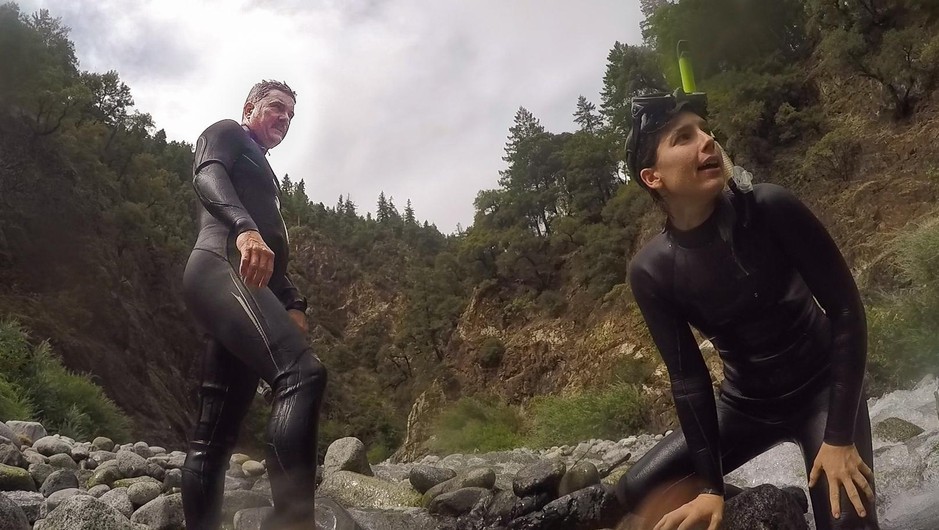
Craig Tucker and Amy Fingerle take a break from snorkling on the Salmon River. This is the last stronghold of wild spring chinook in the Klamath Basin, but on 161 fish were counted this year. CREDIT: Jes Burns/OPB
The fish Hillman speaks of are salmon. There are very few spring chinook in the river, and the fall chinook are late coming back this year.
“We had a great ceremony,” he said. “I think it was just weird not having fish.”
Hillman is also the Karuk tribe’s director of natural resources. The Karuk are behind the accepted petition for Endangered Species Act protection for spring-run chinook salmon in the Upper Klamath and Trinity rivers.
On a similar petition back in 2011, NMFS found that the spring and fall fish in the Klamath River should be considered as part of the same “evolutionary significant unit,” the framework wildlife managers use to categorize and protect variation within a species under the ESA. This time around the tribe is citing the new genetic science as a reason to reconsider that decision.
For Hillman though, the recent genetic discovery doesn’t feel all that new. The tribe, which traditionally relied on salmon as a primary food source, has always considered the two runs to be different fish.
“They don’t show up for the same time of year. So obviously they’re not the same fish,” he said. “We have a different name for them. We call ‘em ishyâat. We call the other ones áama.”
There a buzz around this idea in the salmon conservation community.
“What [the new science] does is it confirms a lot of that traditional ecological knowledge,” said Conrad Gowell, fellowship program director at the Native Fish Society. “Our scientific knowledge is starting to catch up with the knowledge of a lot of the tribes who have acknowledged these populations as distinct for a while, since time immemorial.”
Similar observations have entered the zeitgeist around issues of land management and wildfire.
Hillman is a bit saltier in responding to this meeting of the two schools of thinking.
“I’ve always said that if it’s good science it’ll eventually catch up with what we already know as Indian people, and we’ve always known that spring chinook is a different fish,” he said. “Western science finally caught up to that. Bully for them … Maybe we can do something different.”
Copyright 2019 Oregon Public Broadcasting. To see more, visit opb.org
Related Stories:

Ocean conditions mixed for salmon, leading to average salmon returns
NOAA biologist Brian Burke says mixed ocean conditions may lead to average salmon runs, but climate change is disrupting ecosystems—making continued research critical.

Canadian leaders hope trade negotiations won’t derail Columbia River Treaty
A view of the Columbia River in British Columbia. The Columbia River Treaty is on “pause” while the Trump administration considers its policy options. However, recent comments by President Donald
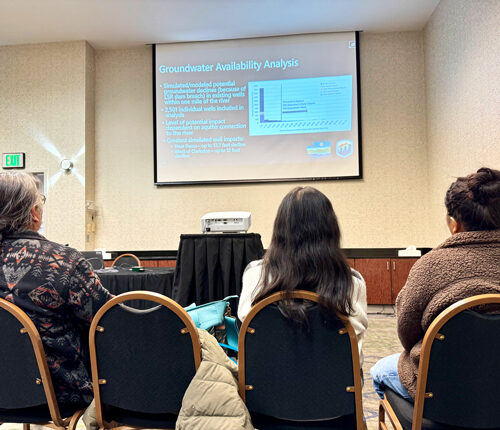
Snake River water, recreation studies look at the river’s future
People listen to an introductory presentation on the water supply study findings at an open house-style meeting in Pasco. After they listened to the presentation, they could look at posters















